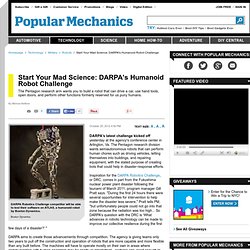

World's 10 Most Amazing Robots. DARPA Robotics Challenge trials to be held December 20-21. The development of robots capable of operating in a melange of disarray and hazards will allow relief agencies to reduce the danger to disaster victims and first responders alike. This is the goal of DARPA's multi-year Robotics Challenge, which in December will pit a variety of robots and software against a series of eight real-world tasks that might be encountered in actual disaster situations. The DARPA Robotics Challenge is aimed at developing a robot that can work with humans at disaster sites, combining their strengths to overcome their weaknesses. While DARPA's Track A teams are developing their own robots as well as the software to attempt DARPA's challenges, Track B/C teams have been supplied with a Boston Dynamics ATLAS humanoid robot for which they will develop disaster-busting software.
The ATLAS humanoid robot is 74 in (188 cm) in height, 30 in (76 cm) from shoulder to shoulder, 22 in (56 cm) thick at the chest, and weighs 330 lb (150 kg) with its hydraulic power controller. Notes for IEEEE paper. U.S. military offers $2 million for first humanoid robot. The United States is challenging every entrepreneur, engineer, developer and inventor to create the first military robot. The individual or team that creates a humanoid robot capable of walking on two legs and performing various tasks — driving vehicles and using tools — will be awarded $2 million by the U.S. Defense Advanced Research Projects Agency. The humanoid army isn’t intended for the battlefield, however; the military is interested in using robots for disaster-response scenarios in which robots will be able to assist service members in high-risk situations. “Robots undoubtedly capture the imagination, but that alone does not justify an investment in robotics,” said DARPA Acting Director, Kaigham J.
Gabriel. DARPA SEEKS ROBOT ENTHUSIASTS (AND YOU) TO FACE OFF FOR $2M PRIZE! [Via Innovation News Daily] Start Your Mad Science: DARPA's Humanoid Robot Challenge. DARPA's latest challenge kicked off yesterday at the agency's conference center in Arlington, Va.

The Pentagon research division wants semiautonomous robots that can perform human chores such as driving vehicles, letting themselves into buildings, and repairing equipment, with the stated purpose of creating bots that could help in disaster-response efforts. Inspiration for the DARPA Robotics Challenge, or DRC, comes in part from the Fukushima nuclear power plant disaster following the tsunami of March 2011, program manager Gill Pratt says.
"During the first 24 hours there were several opportunities for intervention to help make the disaster less severe," Pratt tells PM, "but unfortunately people could not go into that zone because the radiation was too high... So DARPA's question with the DRC is ‘What advances in robotic technology can be made to improve our collective resilience during the first few days of a disaster? ' " DARPA aims to create those advancements through competition.
State of The Art. Research Papers. Robots.stanford.edu/isrr-papers/final/final-13.pdf. When humanoid robots becom... [J Exp Psychol Hum Percept Perform. 2012. Www.mentaldev.org/icdl05/T18.pdf. Www6.in.tum.de/Main/Publications/Kupferberg2011a.pdf. People.csail.mit.edu/brooks/papers/huro99. Web Articles.